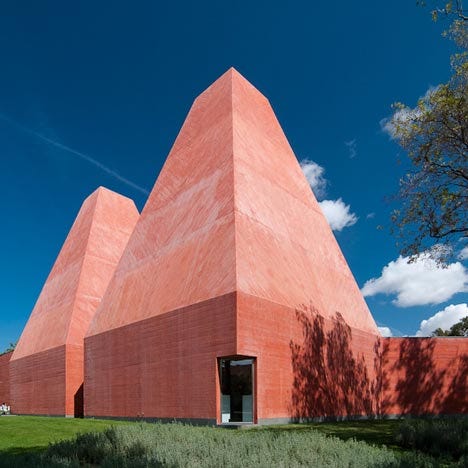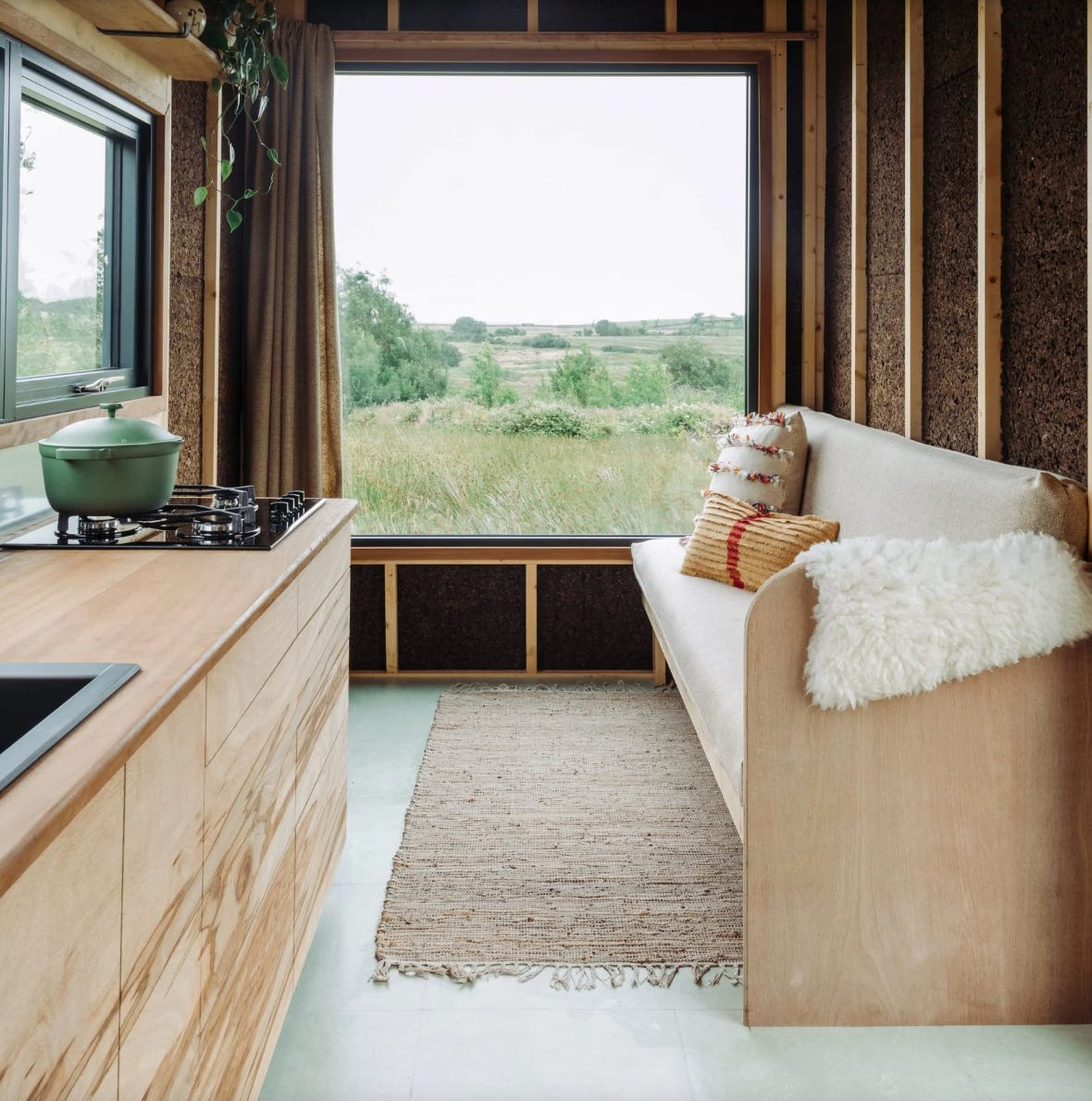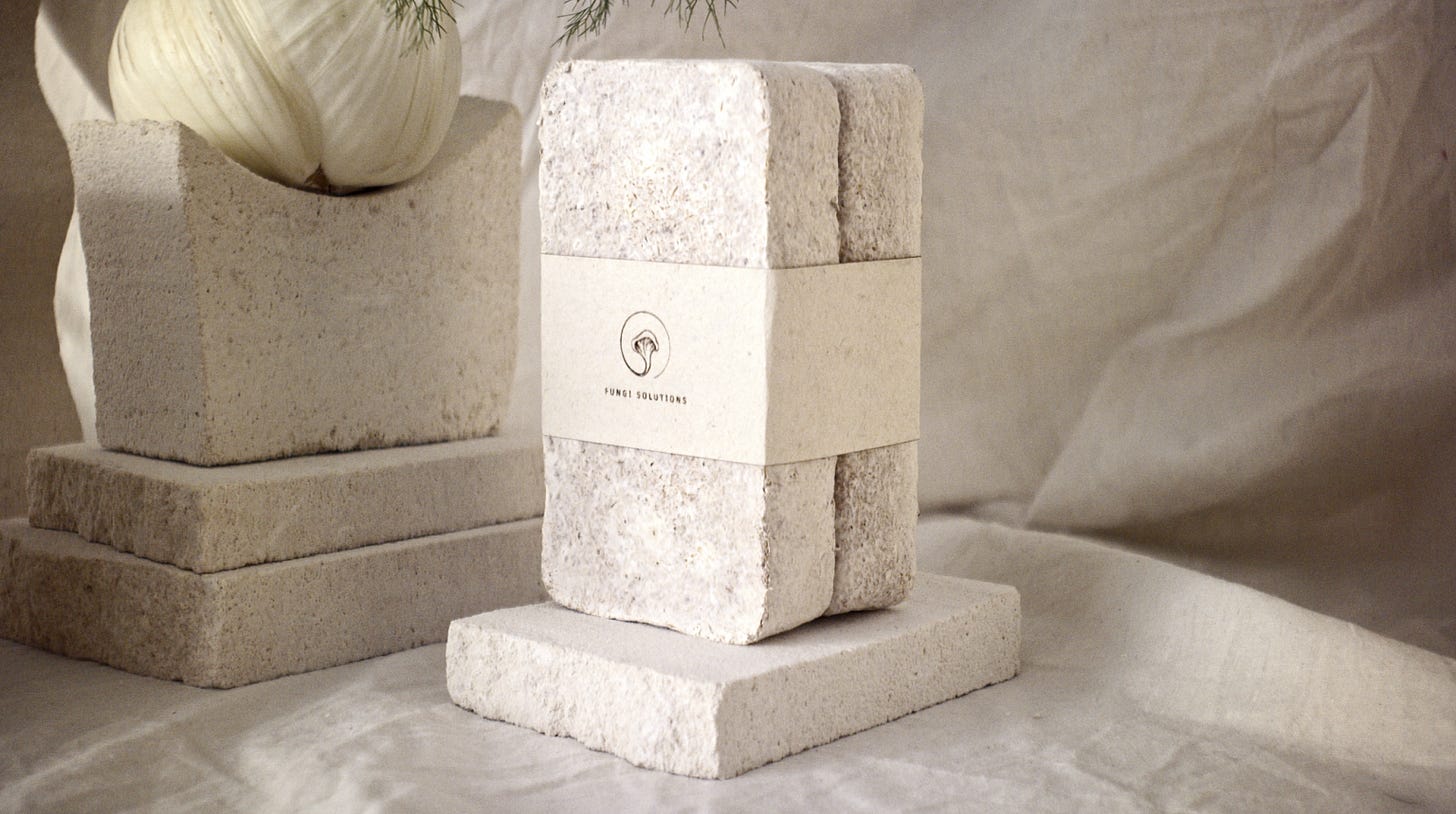Hello All!
I’m excited to announce that we will be bringing in a host of AMAZING guest writers over the coming weeks, with idiosyncratic culinary perspectives, who will expound on a field of topics I adore, but simply don’t know enough about.
This week, however, we’re taking you to a realm of fungi you may not have known existed; It’s a story that even the anti-mushroom brigade might warm to, especially when building a bio-based home.
This newsletter brings you on that journey about the food you were looking for, or perhaps never knew existed. It is our quest to expand on what we don’t know and to share with those who care. The Ómós Digest is a reader-supported publication. Please consider supporting this continued writing, research, and expanding the team by upgrading to a paid subscription for €5 a month. We will love you forever.
Love,
Cúán and the Ómós team.
Set in stone?
Before the birth of agriculture and the establishment of cities, roads, factories, airports, and even villages, evidence suggests that there was an abundance of food available. Unpolluted seas, plentiful streams and lakes, rich grasslands and almost an entire planet covered in forestation, meant earth was a thriving sitopia or food-place (terms coined by Carolyn Steel). Wild animals roamed the land – protein-centric proof that meat (and its byproducts) were in good supply. The waters were dominated by fresh and saltwater fish and mammals for flesh and fat. The skies black with birds, useful for meat, eggs and feathers respectfully. Our forests were abundant with fruit, berries, nuts, insects and wild plants of far wider species than in existence today and used for both food and remedies. And of course, how could we possibly forget fungi.
In contrast to preconceived theories, it appears hunter-gatherers were living in a larder. Despite this abundance, by around 9000 BC when proto-farmers discovered wild wheat could be cultivated, hoed, ploughed, dried, preserved and traded, this equated to food security. Humans quite literally laid roots, formed dwellings and became farmers, which soon morphed into the formation of villages, communities and towns, spreading throughout the world and creating realms and empires. It signalled the advent of farming and is what we now recognise today as the first signs of civilisation. As the population grew and developed, so too did developments in construction. The earliest settlements consisted of small stick huts clad with moss or mud built houses (a precursor to concrete). They were enough to shelter and protect a fire from the elements which transpired into a home built by fire. The earliest form of concrete dates back to 7000 BC and was found in a hut in Israel. This discovery is one completely imbued in meaning. The concrete used for the floor was made by burning limestone to produce quicklime which was then mixed with water and stone and left to set. Fire became the technology we learnt how to control. An incredible engine of opportunity and innovation. However, its relationship with certain stones is now what casts earth's future into doubt.
After water, concrete is the most widely used substance on the planet. Famed worldwide for its ability to resist fire, erosion, rotting, weathering and rusting, it’s the greatest industrial material of our time. A house made with Portland concrete over brick can be made in a fraction of the time. That, plus the fact it's relatively cheap to produce, is the reason why it has come to dominate the construction world and is the answer to every and any industrial development. Its durability is undeniable, with the likes of the Pantheon, Colosseum and Sagrada Familia all having relied on the material. Whether we like it or not, man has been laying the foundations for a concrete jungle for over millennia. Bold, brash, contemporary buildings and brutalist in every regard, like the Kunstmuseum Liechtenstein, Paula Rego Museum in Cascais, The Fritz Wortoba and Peter Eisenman’s austere memorial in Berlin (a tribute to Jews who tragically died in WW2). Each is a dramatic portrayal of the possibilities of concrete and our relationship with it. Although aesthetically, there are many who are opposed to concrete, I find it hard to deny concrete’s beauty.
But (and beware, this is a large but) at a time when the world is experiencing such dramatic impacts of global warming, concrete’s impact on the planet is absolutely devastating. As I write this, Brazil faces its 41st day of consecutive downpour when the nation should be experiencing extreme heat. Similarly, and closer to home, Southern Europe has suffered a summer of record breaking heat and extreme drought, amounting to failed crops and significant doubt in the sustainability of our current food system. Both by use of material and process, the cement industry amounts to one of the main producers of carbon dioxide, a potent greenhouse gas.
“To put things into perspective, all the plastic produced over the past 60 years amounts to 8bn tonnes. The cement industry pumps out more than that every two years.” – Jonathan Watts – The Guardian.
To understand this we need to know how concrete is made. The very word concrete comes from the Latin ‘concretus’, meaning grown together or compounded. It’s a composite of sand, cement, aggregate (crushed, rock or pebbles) and miscellaneous additives. It can also contain steel rods for reinforcement. The most common cement is called Portland Cement due to its resemblance to Portland stone in the hardened state. Much like cooking, modern cement relies on a recipe containing a variety of minerals, mainly limestone. The limestone must be heated to over 1400°C which results in a huge amount of CO2 in the atmosphere and if that wasn’t enough, the limestone itself releases CO2 during the cooking process. The stone is then ground into a powder at high velocity, requiring an output of extreme energy. Following the grinding and blending of minerals, water is added and a simple chemical reaction called hydration takes place, contributing to the final concrete product. The calcium silicates contribute most to the strength of concrete. According to Jonathan Watts, “They also entomb vast tracts of fertile soil, constipate rivers, choke habitats and – acting as a rock-hard second skin.” Quarrying for aggregate taps into resources, while creating dust and thus air pollution and noise pollution. Today, almost a fifth of the world’s waste is either concrete or concrete byproducts. The facts are compounding and very alarming. Yet, it’s plastic we are fixated on. Why? Because concrete doesn’t choke our rivers or harm our wildlife with the same tangible effect as plastic does. We have become desensitised to what occurs outside our urban fortresses - as the saying goes, ‘out of sight, out of mind’. Perhaps it’s time we ask Mother Nature what to build.
Together, building and construction are responsible for 39% of all carbon emissions in the world (IGBC, 2019). As the industry continues to boom, and the need for housing never higher, is there any hope for ecological redemption? Climate change is an economic issue and consequently, it might be unlikely that we see industrial construction moving away from concrete anytime soon (at least not until a material that equals the pros of concrete is sourced). However, a number of startups are taking measures to produce construction material with minimal carbon impact. Ferrock for example, is a material that uses waste steel dust and ground silica glass, mixed with ferrous rock to produce a bio based material. It’s actually five times stronger than concrete. Hempcrete is made using the dried woody core of the hemp stalks, mixed with lime. Lime is made by heating limestone (an abundant stone) but requires much lower temperatures (900°C) to produce the calcium oxide used as a binder. While Hempcrete can be cast, unlike concrete (which produces vast degrees of carbon), it sequesters carbon from the atmosphere. According to a recent study, hempcrete can sequester almost 9kg of CO2 per cubic foot, roughly the equivalent of the annual carbon emissions of three refrigerators. That means that while the hemp grows, more CO2 is being pulled from the atmosphere than it actually takes to produce the hempcrete!
“Across the globe, in the wake of two of the most challenging years in living history, people are taking a moment for reflection and re-calibration. A moment to reconsider what a sustainable, joyful life could look like for them, and how they might set about creating it.” Harrison Gardener
One organisation using hemp as a construction material in Ireland is Harrison Gardener - a good friend and remarkable craftsman who established Common Knowledge in 2020. Harrison has travelled all over the globe, working with communities to learn and share skills surrounding construction. The multifaceted Common Knowledge tackles the escalating need for housing in Ireland, increasing quality of life through joyful and sustainable living. By providing people with a range of basic skills and resources and connecting as a community, they equip people with the wherewithal to build their own home. The fruit of that compulsion is Tigín (meaning little house in Irish): sustainable, affordable, tiny homes that place the ancient skills of our ancestry back in our hands.
Fungi materials
Fortunately, there is a whole host of materials that place the planet first, some of which you can find here. But, as this is ‘fungi month’, I want to bring to your attention a material formed by inoculating construction waste with mycelium spores such as oyster mushrooms. This a mushroom-based material, not made but grown.
From our last fungi-related article, we know what mushrooms are and how they grow in the wild. But just like cows are raised for beef, the mushrooms we pick up in the supermarket are cultivated by way of mushroom farming. By harvesting and drying the spores, for years, mushrooms have been cultivated mostly in contained environments and grown from organic matter like spent coffee grounds or saw dust. Today however, mushrooms are not only grown for your plate thanks to companies like Ecovative Mushroom® and Myceen.
Fungal mycelium is now being used to produce ecological building bricks that have the potential to replace conventional materials. What is unique about this material is that it doesn't use mineral matter (like limestone) as a binder. Mycelium easily colonises soil and many other substrates, practically acting as a glue that binds together different natural particles. It’s also 100% biodegradable. Because mycelium has the ability to multiply fast, the material is sequestered to heat upon finishing stage to deactivate the fermentation process (otherwise your house might become living mycelium). The material itself is comparable to untreated wood and will expand and decompose over time. For this matter, it sounds like it’s probably best to use the material in conjunction with other materials, protected from the moisture (much like this house built using hempcrete). Although this might mean mycelium may not be on the verge of entirely replacing concrete any day soon, it doesn’t mean the material is without its uses. Architects and designers have found truly beautiful uses for the material just waiting to be put to good use. Here are just a few of those…
Materials and ‘meatless’ food
Ecovative are arguably the leaders in mycelium based technology. They're producing everything from mycelium leather, foam and packaging to some pretty scary looking mycelium bacon.
Thermal and acoustic insulation
According to Ecovative, mushrooms packaged between wooden panels can form an effective wall of insulation. Different from most insulation (even other bio products like hempcrete) the mushrooms are allowed to grow between the wood, which causes the mycelium to push its way into any holes and crevices. This means it becomes airtight, reducing any chance of cold air or sound gaps. The insulation then dries out over a month, becoming inactive.
Acoustic panels
Often it is the case that old buildings have bad acoustics. It wasn’t a priority back then. Today though, communal spaces like restaurants and bars are actually judged by their acoustics. As a result, we often see preventative measures put in place, usually in the form of foam which I always find looks like a series of yoga mats on the roof. Myceen tackles this issue with a really beautiful collection of mycelium acoustic panels.

Polypore mushroom furniture
Mari Koppanen creates furniture inspired by polypore mushrooms (a group of fungi that form large fruiting bodies with pores or tubes on the underside). She unites wood, wool and fungus into a tangible marriage of materials. FOMES is the furniture collection she created, consisting of two pieces of polypore seating that imitate the characteristics of the mushroom.
Lighting
Welsh design firm Tŷ Syml alongside Nino+Co designed pendant lamps for zero-waste restaurant, Silo, in London. The lamp shades are made using wood waste which has been inoculated with mycelium. They rather remarkably take only 5 days to grow!
Stools and side tables
Myceen are also designing double use interior products. Their solid mushroom square stools or side tables offset several kilograms of carbon. Each piece is entirely unique due to the naturally used material of mycelium.

Art:
Speaking to former lead creative of Danish design Studio FRAMA, Cassandra Bradfield, informed me that a number of artists are using mycelium as their medium of choice, ‘‘They are primarily working in the art/installation realm but their work is based on growth. In many ways most of their artwork they “grow” in one way or another,” Studio Think Hand is one of those, who produce mycelium panels similar in texture to styrofoam and could be used as alternatives to plastics, heat and sound insulation, and surfboards! Produced in collaboration with the amazing Krown Design.

Packaging
Mycelium packaging is produced in a very similar way as the light pendulum. It contains only two ingredients: hemp hurd and mycelium. Hemp hurd is a byproduct of the fibre hemp industry. Companies like IKEA are beginning to replace styrofoam with it. Fungi Solutions look to have created a pretty beautiful product.
Continue the conversation by letting us know about any other bio-based materials or companies in the comments below!











